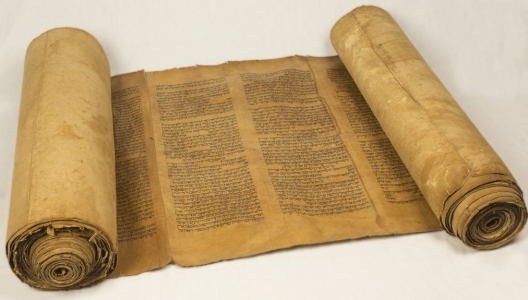

Alexander the Great

Jerome and the Latin Vulgate
In 1450 B.C., Moses begins to record God's word and produces the Pentateuch in Hebrew. Subsequent prophets and men of God record God's word during their
lifetimes with the prophet Malachi as being the last at around 430 B.C. Hebrew was the language of the ancient people of Israel. Most of the Old
Testament was written in Hebrew.
Aramaic, a Semitic language closely related to Hebrew, was the second biblical language. Only about ten chapters in the Old
Testament were written in Aramaic. When the people of Israel returned to Palestine after their exile in Babylon around 500 years before Christ, they brought
the Aramaic language with them. While Hebrew was the official language of temple and synagogue worship, Aramaic was the language of the common people of
Palestine. Jesus and his disciples spoke Aramaic in their normal daily conversations. Several times in his Gospel, Mark quotes the words of Jesus in Aramaic
and then translates the meaning for his original readers because most were not from Palestine and did not understand Aramaic.
After the Neo-Babylonian and Achaemenid empires, the Greek Macedonian empire (323-168 B.C.) introduced the world to Greek art and literature and
Koine Greek became the language of commerce and politics. As Jews dispersed and emigrated to other regions of the Mediterranean, they spoke Koine
Greek.
For this reason, around 280 BC, work began in the ancient Egyptian city of Alexandria on a new translation of the Scriptures. The result
was the Septuagint, a translation of the Old Testament into Koine Greek. Though Jews continued to revere the Scriptures in their original Hebrew, by
the time of Jesus and his disciples the Greek Septuagint was the Bible of popular choice. It became the Bible of Jews all around the empire.
Since most of the first Christians were Jews, the Septuagint became their Bible of choice too. When the New Testament was introduced, it
was written in Koine Greek with some Hebrew and Aramaic loan words. Many of the Old Testament quotations that appear in the New Testament are actually
quotations from the Septuagint.
Succeeding the Greek Macedonian empire, the Roman empire introduced Latin, which was the language of the educated Roman. As Christianity spread
from the working and merchant classes to the upper levels of Roman society, the church saw the need for a translation of the Bible in Latin. Between the years
390 and 450 AD, a priest named Jerome, also known as Eusebius Hieronymus, produced a translation of the entire Scriptures in Latin. A dedicated and careful
scholar, Jerome set out to revise and correct previous inferior translations. And, to a very large degree, he succeeded. He seemed to have had a good Hebrew
manuscript from which he translated all of the Old Testament except the Psalms.
Jerome's translation was not perfect. No translation is. Still, his work set a high standard of quality and preserved the integrity of the
Scriptures from well meaning but careless or poorly qualified translators. Later known as the Latin Vulgate, it was the standard for all Christians in
Western Europe until the Protestant Reformation.
With the spread of Christianity during the four centuries after Christ, the Scriptures of both the Old and New Testaments were translated into such ethnic
languages as Syriac, Old Latin, Coptic, Ethiopic, Gothic, Georgian and Armenian. Some of these translations were made by people who had more missionary zeal
than linguistic skill. As a result, some were of poor quality.
Chapters and Verses
Early manuscripts indicate that the books of the Bible had some form of divisions.
Evidence suggests the possibility that Hebrew manuscripts divided the Pentateuch into 54 reading sections during the Babylonian Captivity
(before 536 BC); thus, the Pentateuch was read completely in a year.
Another form of division also existed. When there was a change in subject, there was either an unfilled line of text or a blank line
before a new full line.
However, despite these two forms of divisions, the earliest Hebrew manuscripts did not have any division into numbered or alphabetical
chapters.
In 1205, Paris theological professor Stephen Langton was the first to make chapter divisions to facilitate his work with Bible commentaries. He later
became the Archbishop of Canterbury and was a prolific writer of commentaries and biblical essays, which introduced his chapters. In 1240, Cardinal Hugo
of St. Cher published the first Latin Bible with the chapter divisions that exist today. The Jews started using the same chapter divisions in 1330 for
their Hebrew Bible.
In the oldest Hebrew manuscripts (Masoretic), the Old Testament was divided into verses; however, the verses were not numbered. This notation helped
the scribe make an accurate copy, specifically to guard against the addition of verses, and helped the teacher read and remember all the verses.
Jewish rabbi philosopher, Isaac Nathan ben Kalonymus, adopted Langton's chapter divisions of the Old Testament and numbered the verses
according to the Masoretic verse divisions. In 1523, he wrote the first Bible concordance in Hebrew, the "Meïr Netib," to facilitate the study of Biblical
exegesis and to prevent Jews from converting to Christianity. It may be worthwhile to note that the verse numbers in Hebrew Bibles are at times off by one
or more verses from the English verse numbers, because Christian Bibles do not count introductory verses (i.e. Hebrew Bible Psalm 20:2 is the same verse as
the Christian Bible Psalm 20:1).
Robert Stephanus (also known as Robert Estienne), a Protestant book printer living in France, printed Greek and Latin Bibles that French ecclesiastical
authorities considered heretical. As he fled with his family to Geneva on horseback, he arbitrarily made verse divisions of the New Testament within Langton's
chapter divisions. In 1555, Stephanus printed his first Latin Bible with his New Testament verse system.
However, Stephanus' work was not the first Bible printed with New Testament verse divisions. In 1538, seventeen years earlier, a Latin
Bible was printed with different verse divisions, but it was Stephanus' version that was used for the first English Bible - The Geneva New Testament of 1557,
which became the verse system used today.
It is important to realize that they were completely arbitrary. They were not applied with any logical or consistent method, do not represent literary
units, and do not define the author's unit of thought. The Bible was not intended to be read in bits and pieces! Chapters and verses are simply a reference
point and should not be used to influence the interpretive approach of the Bible student!
Copyright ©
2022
Helpmewithbiblestudy.org. All rights to this material are reserved. We encourage you to print the material for personal and
non-profit use or link to this site. If you find this article to be a blessing, please share the link so that it may rise in
search engine rankings.